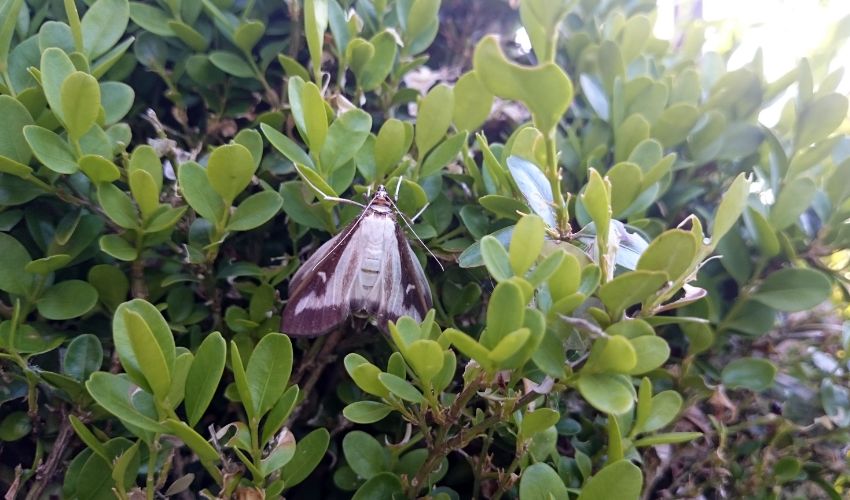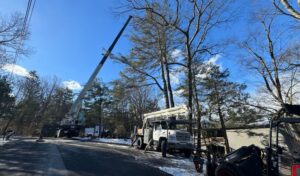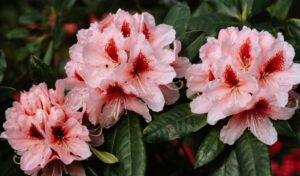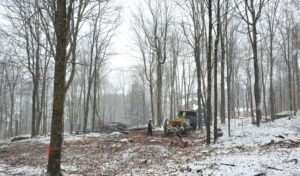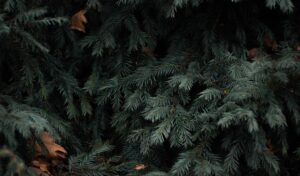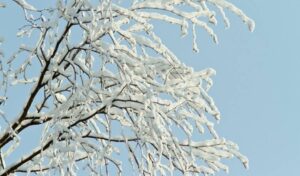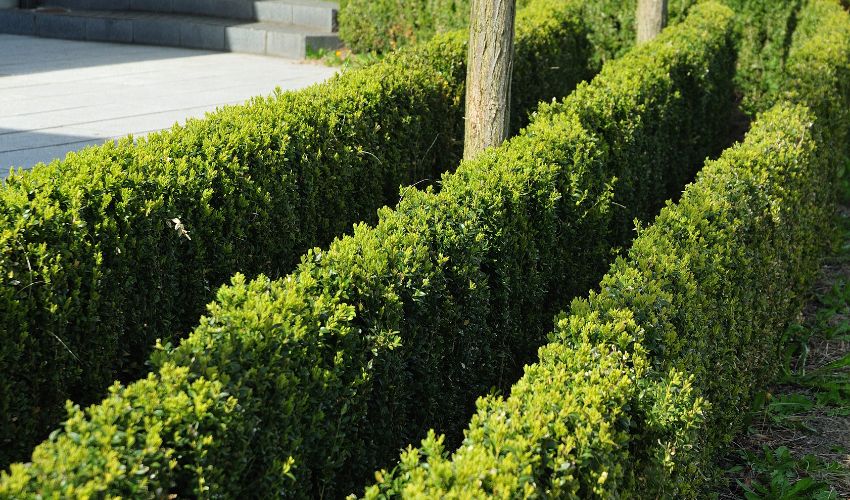
Boxwoods are some of the most popular shrubs in the Hudson Valley but are prone to damage, defoliation, and even death from a range of destructive pests. Discolored and curling leaves, blistering, sooty mold buildup, dying branches, swarms of orange flies, and premature leaf drop are just a few of the many signs of infestation from common boxwood pests like mites, boxwood leafminers, and boxwood psyllids.
If you notice signs of stress or damage to your boxwoods, check the symptoms below to see which pest may be attacking your shrubs, how to treat the problem, and steps you can take to prevent it from happening again. Infestations increase the risk of permanent damage to your shrubs and, if left unchecked, some of these pests may kill the plants without timely treatment. Dealing with severe infestations often requires professional pest treatment.
Key Takeaways
- Boxwoods are resistant to deer but have several pests that may harm them.
- Boxwood mites typically do aesthetic damage and are easy to remove without pesticides.
- Boxwood psyllids are not life-threatening to the shrubs but will damage the leaves.
- Boxwood leafminers will cause plenty of harm to your boxwood, and you’ll want to hire an arborist to treat them as soon as you can.
- Box leaf moths are an invasive species that can quickly decimate your boxwoods if left unchecked. While not yet found in the Hudson Valley, keep a close eye on your shrubs and report it if you see any signs of this destructive pest.
Boxwood Shrubs: Beloved but Plagued by Pests
Boxwood (Buxus spp.) is a traditional plant used for hedges and topiary and is the highest-selling evergreen shrub in North America. It’s an incredibly popular choice in the Hudson Valley for a simple reason: they are relatively deer-resistant. Nobody wants to see all their hard work trimming and maintaining their shrubs go to waste due to hungry deer. Luckily, deer are not interested in boxwoods, meaning you can keep your landscape looking great without having to worry about half-eaten shrubs.
While we see many boxwoods in the Hudson Valley area, they do have their drawbacks. Many boxwood cultivars are prone to attack from pests and diseases, necessitating frequent inspections and maintenance.
Before planting boxwoods on your property, you’ll want to do some research about the different cultivars to understand which have the most disease and pest resistance. Some cultivars may stand up to pests better than others, and it’s worth speaking with an arborist who can advise you what to buy and how it fares against common boxwood problems.
Common Boxwood Pests in New York’s Hudson Valley
There are three common pests that typically attack boxwoods in our area:
- boxwood mites
- boxwood psyllids
- boxwood leafminers
Of the three, boxwood leafminers pose the biggest threat to your shrubs, though you’ll want to deal with any of these pests as soon as possible to avoid damage to your plants.
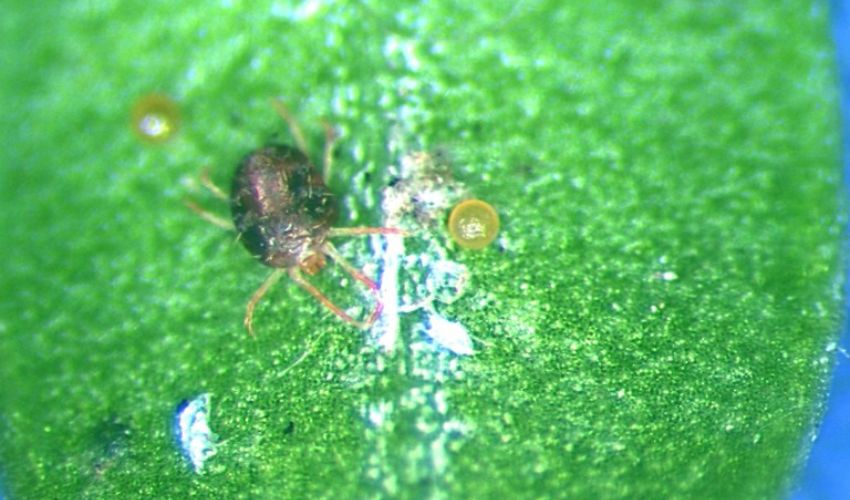
A close-up look of a female spider mite and eggs on boxwood leaf, photo by Rayanne Lehman, Pennsylvania Department of Agriculture, Bugwood.org
Boxwood Mites: Tiny but Destructive
Boxwood mites (Eurytetranychus buxi) are tiny spider mites that feed on the leaves of boxwood shrubs, particularly during spring and early summer. They typically only cause superficial damage to the shrub’s foliage, but heavy infestations can lead to premature leaf drop and defoliation. Although they don’t kill boxwoods, dealing with these pests as soon as possible will help you avoid unnecessary damage to your shrubs.
Identifying the Boxwood Mite
Boxwood mites are tiny (only 0.5 mm long, or about the size of a period), and difficult to see with the naked eye.
Adult mites lay eggs on the undersides of leaves that overwinter there and hatch out in early spring. Boxwood mites rapidly multiply, hatching several generations a season. You’ll see them most prominently in the summer, especially if we have dry, dusty conditions.
Symptoms of Boxwood Mite Infestation
There are several key symptoms that indicate a boxwood mite infestation. Here’s what to look for:
- Small white, yellow, or bronze streaks/speckles that look like fine scratches or pin pricks on the upper surface of the boxwood leaves. This is caused by the mites feeding on the undersides of the leaves.
- You may see round, greenish mite eggs on the undersides of infested leaves, especially in spring. Later in the season, adult mites may be visible on the undersides of affected leaves (although you’ll need a magnifying glass to see them).
- Leaves may appear slightly blistered or discolored (yellow to brownish) as feeding damage worsens.
- In severe infestations, shrubs may drop their leave prematurely, leading to defoliation and twig dieback.
How to Treat Boxwood Mite Infestations
The choice of treatment for boxwood mites depends on the severity of the infestation. However, the key with any treatment approach is to start early in spring before mite populations build up, thoroughly cover the undersides of leaves when spraying, use multiple complementary methods, and maintain a consistent monitoring and management program.
For minor infestations, hosing down plants with a strong stream of water can physically dislodge and remove many mites from the leaves. To be effective, this needs to be done thoroughly and repeated regularly.
Horticultural oils or insecticidal soaps can also provide some control of boxwood mites. These treatments are sprayed on infested leaves during the summer to smother and kill boxwood mite eggs and adults without using conventional insecticides.
If the infestation is more severe or widespread, an arborist may recommend using conventional insecticides and miticides, with the active ingredients being rotated between treatments to prevent resistance. Systemic insecticides can be applied as soil drenches or injections to move the insecticide into the plant and kill mites feeding on the foliage. Other treatments are sprayed directly on the leaves.
It may also be necessary to prune off and destroy heavily infested branches and plant debris to reduce boxwood mite populations.
Preventive Measures to Avoid Infestations
Preventive measures for boxwood mites typically involve applying using horticultural oils in the winter to smother the pests while they are dormant.
Another step you can take is to avoid using high nitrogen fertilizers as these can encourage boxwood mite reproduction.
Because boxwood mites prefer feeding on European and American boxwood varieties, if you plan to plant boxwood shrubs, select varieties that show resistance to mites, like some Japanese boxwood cultivars (Buxus microphylla var. japonica).
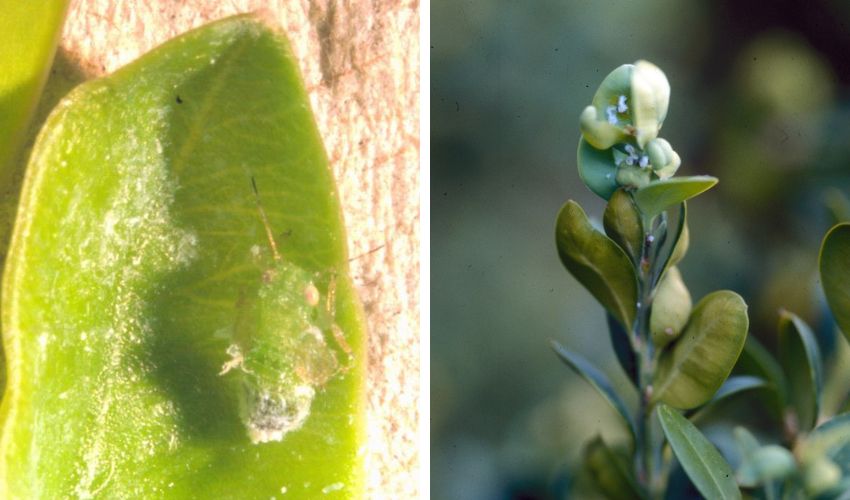
Left: A close-up of a boxwood psyllid nymph by Nancy Gregory, University of Delaware, Bugwood.org
Right: Boxwood psyllid cluster on leaves by Daniel Herms, The Ohio State University, Bugwood.org
Boxwood Psyllids: How to Spot Them and How They Damage Your Plants
Boxwood psyllids, Psylla buxi, are tiny, sap-feeding insects that cause a distinctive cupping and distortion of new boxwood foliage each spring through their feeding.
Like mites, boxwood psyllids, are not deadly to plants, but they can cause aesthetic damage.
These pests are tiny insects, about 1/16 inch long as adults, that resemble miniature cicadas or leafhoppers. The nymphs (immature stage) are light green and produce white, waxy filaments that cover their bodies, giving them a woolly or fluffy appearance.
There is typically one generation of boxwood psyllids per year. They overwinter as orange eggs between bud scales, then emerge as nymphs in April-May to feed on the new growth and mature into adults by late May-June.
Signs That Psyllids Have Infested Your Boxwood Shrubs
A boxwood psyllid infestation produces tell-tale signs that are easy to spot if you know what you’re looking for. These include:
- Cupping and distortion of the new leaves at the branch tips. Feeding by the nymphs causes the new growth to become cupped and twisted.
- White, waxy filaments or fluffy coatings on the leaves. This is produced by the nymphs as they feed inside the cupped leaves.
- New foliage will look stunted. Heavy infestations can also stunt the growth of new shoots.
- Honeydew and sooty mold buildup on leaves below infested areas. The psyllids excrete sticky honeydew as they feed, which can lead to sooty mold growth.
- Galls or enclosed leaves partially protecting the psyllids inside.
While unsightly, the damage from boxwood psyllids is generally just cosmetic and does not severely impact the overall health of established boxwood plants.
Controlling Boxwood Psyllids
Professional treatment is often unnecessary unless the infestation is severe. The key is to time insecticide applications for when the psyllid eggs hatch and nymphs emerge in spring before they become protected inside the cupped leaves.
If necessary, systemic insecticides can be applied as a soil drench 2 to 3 weeks before eggs are expected to hatch in spring. The insecticide is taken up by the shrub and kills the nymphs as they feed.
How to Prevent Psyllid Infestations
Prevention is the best option for dealing with psyllids. Stressed plants are more susceptible to psyllid damage so practicing proper cultural care can help keep them healthy.
Spraying plants with horticultural oil in late winter/early spring (before bud break) will smother overwintering psyllid eggs, significantly reducing the number of pests feeding on your shrubs.
Inspect plants in spring and prune off any cupped, distorted new growth harboring psyllid nymphs before they mature into adults. This reduces the number of adults that can lay eggs for next year’s generation. Ensure you dispose of them properly to prevent the psyllids from infesting other leaves or getting on your skin. Psyllids will bite humans, though their bites are not particularly painful.
Some boxwood cultivars have shown resistance to these pests. If psyllids are a regular concern, you may opt to replace existing plants with some of these Japanese boxwood (Buxus microphylla var. japonica) cultivars:
- ‘Green Pillow’
- ‘Franklin’s Gem’
- ‘Richard’
- ‘Nana’
- ‘Pendula’
- ‘Handworthiensis’
- ‘Vardar Valley’
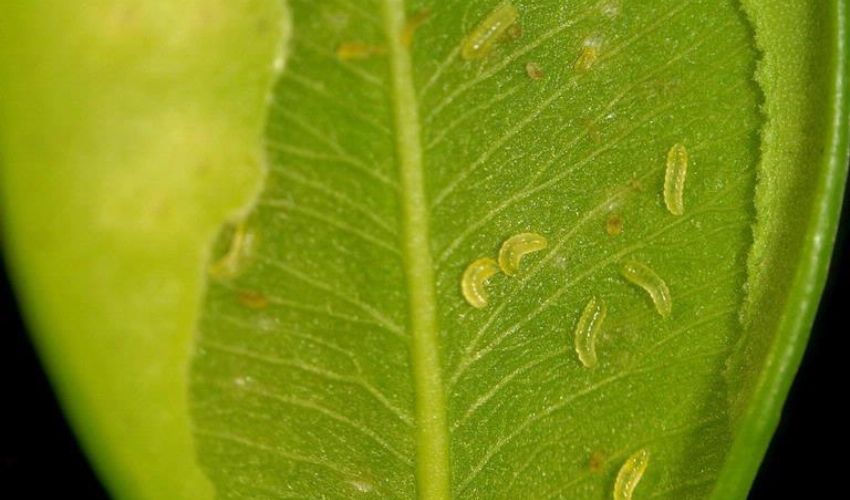
A close-up look of a Boxwood leafminer by Brian Kunkel, University of Delaware, Bugwood.org
Boxwood Leafminers: Destructive Boxwood Killers
Boxwood leafminers, Monarthropalpus flavus, pose the most danger to your shrubs compared to psyllids or mites, and you’ll want to be proactive and quick to stem the spread and limit the damage. Boxwood leafminers make their first appearance of the season in the spring, although you may see them earlier in the year if the weather is warmer.
How to Identify Boxwood Leafminers
Leafminers are small flies or midges, about 2-3 mm long, that appear yellow, orange, or reddish in color as adults. If you give your boxwood bush a gentle tap and see orange insects fly out, you likely have an infestation on your hands. These adults are not the biggest concern, however, as the larvae and eggs are the most damaging to your shrubs.
Signs of a Leafminer Attack
The adult females insert eggs into the leaves, and the larvae (maggots) hatch and burrow between the upper and lower leaf surfaces, creating winding tunnels or mines as they feed. This feeding causes the leaves to develop blisters, yellow or brown discoloration, puffiness, and distortion. Heavily infested leaves may drop prematurely.
While unsightly, the damage is mainly aesthetic rather than fatal to established plants. However, repeated leafminer infestations can weaken boxwoods over time and make them more susceptible to other stresses.
If left unchecked for long enough, leafminers may even kill your shrub.
Treatment of Boxwood Leafminers
Treatment for boxwood leafminers typically requires pesticides to control the population. As with boxwood psyllids, you should apply systemic insecticides as a soil drench or basal bark spray 2-3 weeks before the expected egg hatch in spring. These insecticides are taken up by the plant and kill the leafminer larvae as they feed on the leaves.
Contact insecticides and insecticidal soaps can also be helpful when sprayed directly on the foliage as the adult flies emerge in spring. Be sure to thoroughly cover all leaf surfaces, especially the undersides.
Preventive Measures to Stop Leafminers
Apply horticultural oil sprays in late winter/early spring before bud break to smother overwintering leafminer eggs.
Prune off and destroy any heavily blistered, infested leaves and branches in early spring before the adults emerge. This reduces the leafminer population for the next generation. Time pruning for when you hear the crackling/popping sounds of the larvae moving inside leaves, but before you see any adult flies.
There are several boxwood cultivars with resistance to leafminers, and a certified arborist can assist you with identifying the best cultivar for your needs.
Some of the cultivars we recommend with resistance to leafminers include
- ‘Glencoe’
- ‘Fiorii’ and
- ‘Arborscens’
NewGen boxwood cultivars like ‘Green Velvet’ and ‘Green Mountain’ are also being bred for leafminer resistance.
An Emerging Threat to Your Boxwoods: Box Tree Moths
Box tree moths, Cydalima perspectalis, are an invasive pest native to North China and Korea that can quickly damage or kill boxwoods. The first sighting of box tree moths in the United States occurred in upstate New York in 2021. Although they haven’t yet reached the Hudson Valley, be on the lookout for this destructive pest. If you see something that looks like box tree moth, please submit a report to NYS Department of Agriculture and Markets through their Box Tree Moth Public Report portal.
You may notice the moths themselves, see lime-green caterpillars with black stripes, or extensive webbing throughout the shrub’s interior. The caterpillars are heavy feeders, quickly stripping leaves of all but the midrib and leaving green-black balls of frass (droppings) on remaining leaves and beneath the shrub. Severely-infested shrubs take on a brown or scorched look.
The USDA says it is difficult to eradicate box tree moths once they get a foothold in the area. You should contact an arborist to use chemical sprays to try and kill the larvae and stem the population growth.
What to Do if Your Boxwoods Aren’t Looking Too Hot
If you notice problems with your boxwoods, especially if the symptoms seem similar to the ones caused by leafminers, mites, or psyllids, you will want to seek treatment for the pests.
Our team at Hill Treekeepers can look at your boxwoods or other shrubs, recommend a treatment plan that’s right for the problem, and advise you on any useful methods for preventing further pest infestations.
Ragged-looking boxwoods may also point to boxwood blight, and we can diagnose the issue and ensure we get the right treatment option for your issue.
Hill Treekeepers Can Help You Control and Prevent Boxwood Infestations
Boxwoods are popular in the Hudson Valley for their built-in resistance to deer. However, these shrubs are prone to infestations by a range of common pests, leaving them looking unattractive and sometimes killing the shrubs outright. Taking care of your boxwoods will leave them looking beautiful and your yard the talk of the town.
If you notice your boxwoods are looking damaged or less vibrant than normal, you may have an unseen infestation causing problems. Our team at Hill Treekeepers can help get your shrubs back in tip-top shape. Give us a call at 914-214-7045 or request a quote online to learn more about our services and how we can help.
Share this online!
Get the highest quality of tree services for residential and commercial properties in the Hudson Valley area. We look forward to working with you!
TOPICS
Recent Articles
Don't Miss the Next Update!
Join the thousands of smart Hudson Valley residents who get the monthly newsletter from Hill Treekeepers. It's full of helpful information you won't want to miss!

